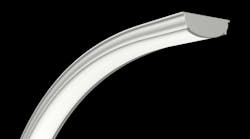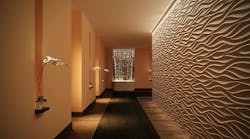Date Announced: 11 Jul 2006 Toulon, France – OPTIS, the world leading 3D lighting technology provider announces for 2006 some major new product capabilities. After having being the first to include the lit appearance in its simulation process and to integrate CAD software, OPTIS has now added the possibility of optimizing design through the use of several very innovative tools. Here the optimisation of a car tail-lamp design clearly illustrates the advantages of these new SPEOS technology tools. Thanks to the fact that the software is integrated in CATIA V5, optics and mechanics can be treated together. Thus opto-mechanics can be optimized at the same time. Moreover new developments allow designers to improve the optics parts of a system using very efficient tools. It is possible to automatically generate optical shapes (parabola, conics…) and to create assemblies made of several optical elements. The software is able to generate and to automatically position a set of optics. For instance a car tail-lamp is made of more than 100 optical pillows. The optical feature used by SPEOS CAA V5 Based will drive, in only one run, the generation of these 100 pillows taking into account all the optical requirements. Position and orientation will automatically follow the propagation rules the designer sets. Thus, optical knowledge is encapsulated in this optical feature and can be applied to complex system design.In this way, photometric simulations (SPEOS Light Modeling – photometry) can be performed very rapidly. Then the analysis of the light propagation in the system and the photo-realism simulation taking into account human vision properties (SPEOS Visual Ergonomics) can be done from the optimized design. Moreover calculations can now be launched on a PC cluster. This drastically reduces the calculation time. In this way lit appearance of a tail-lamp for instance can be obtained very rapidly with a high level of realism.As a final result, a tail lamp can be simulated to give both lit and unlit appearance. All the small optical pillows of the tail-lamp (see below) have been very easily designed and optimized thanks to these very innovative tools. Moreover, exterior conditions such as night, day and weather can be included in the simulation to increase the level of realism.It is also possible to easily modify the kind of bulbs and lenses to look at multiple "what-if" scenarios. Many benefits come with these unique SPEOS Technology capabilities. Firstly, automatic “optical features” bring high value to the design product process. If you consider a 100-pillow tail-lamp, without the automatic optical feature, you needed to design each pillow one after one. It meant that you spent a lot of time doing repetitive tasks and adjusting optical elements. With the new automatic “optical features”, the design and the product development lifecycle are drastically shortened. Time to market is improved. Moreover “optical features” allows know-how to be encapsulated in automatic routines. Then they can be saved and diffused into the company. Not only will optical specialists save a lot of engineering time but they will also share their expertise internally.Secondly, distributed calculation (PC cluster) divides the simulation time. It offers more power to use the optimization tools such as the “optical features” because more and more calculations can be run. SPEOS software can compute more and more complex systems and increase the degree of realism of the simulations. It becomes easier to virtually validate prototypes without building physical ones. About OPTIS OPTIS is the first company to provide a light simulation solution fully based on a physical model inside CAD/CAM software. Its solutions allow designers and engineers to analyze and optimize the lighting performance of products. In 2002, OPTIS integrated its SPEOS solution in CATIA V5 to launch the SPEOS CAAV5 BASED solution.Since its creation in 1989, OPTIS has delivered more than 5000 licences to 1000 customers, in more than 35 countries worldwide including major automotive, aerospace, electronics, white goods and lighting manufacturers, as well as universities, research laboratories and defence agencies. Products such as automotive exterior and interior lighting, cockpits, mobile phone screens and keypads, LCDs, LEDs, lights, and architectural lighting can all be optimized using the SPEOS technology.SPEOS integrates photometry, colorimetry, lighting simulation capabilities fully based on physics, into the PLM chain. Its live-measured library of material, sources and sensors brings highly realistic virtual prototypes, giving light information. Its unique eye-vision model provides answers about the perception of a 3D environment such as a human-machine interface, often needed for ergonomy and safety applications. Its unique colorimetry, visual ergonomics, and lighting solutions set a new precedent in digital mockup.
Contact
Angela Green Communications Manager, OPTIS ZE La Farlède, BP 275, 83078 Toulon Cedex 9, France Phone: +33 4 94 08 66 90 Fax: +33 4 94 08 66 94
E-mail:[email protected]
Web Site:http://www.optis-world.com






